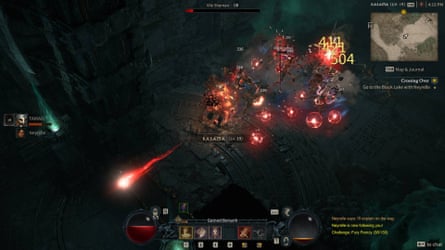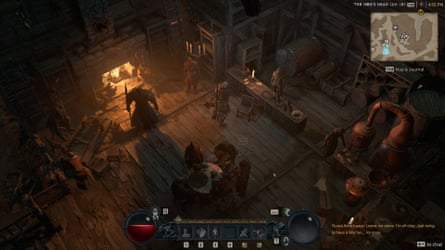Diablo 4 wants you to know that it’s very serious indeed. From its gripping introduction, evoking Blizzard’s Warcraft 3-era heyday of best-in-class cinematics, to the richly macabre backdrops that host its continuous loop of demon-slaying ultraviolence, this is a game with a mission statement: please don’t make fun of us for being too cartoonish, like you did with Diablo 3.
It’s done well, for the most part. The writing harkens back to Diablo’s original two outings; a gothic, low fantasy miasma of hopelessness and intrigue. Most impressively, this version of Diablo’s world feels, well, like a world again; a place with history and tension, rather than a collection of maps strung together to facilitate dungeon delving.
But despite the rewarding interplay between various stats and buffs, and the laudable sensation that, even very early on, you have access to the sort of freedom in character and combat customisation that’s typically locked away for hours in similar games, Diablo 4 feels … toylike. Strip away the hellish screams and scarily convincing Halloween costumes, and what’s left is the video game equivalent of hyper-palatable junk food, albeit with myriad colourful warnings on the packaging.
Decades’ worth of talent and knowhow have been spent here on boiling down moreishness to a fine science. Diablo 4 may look and sound ominous, but in practice, it all goes down a bit too easily. This might be exactly what you’re looking for: a vivid and well-realised hellscape to escape into, one that bites back just enough for you to feel present, but never really tested. It is, like junk food, exceptionally tasty, but oddly insubstantial, like a doppelganger of something much more real.
An example: I tried out the Druid class, a beefy frontline fighter with access to shapeshifting, animal companions and a host of lightning spells. Even from those first few precious skill points, it’s clear that you could take the Druid in a few distinct directions – make them a slow and devastating werebear, for example, or a wolf-pack leader. I went with a caster that stuns with sheets of summoned lightning. It’s all suitably impressive to look at, with nary a dropped frame in sight as the action gets busy with pyrotechnic flair. But once I had accrued some decent armour and protective spells, I found myself more or less on autopilot for hours as the hordes of hell fell before me.
It makes for a strange disconnect between atmosphere and play. Diablo 4’s art, sound design and worldbuilding all go to extraordinarily impressive lengths to convince you that this is a grim, dangerous world. It’s just a shame there’s so few encounters that support this. It all feels less like a gauntlet, more like a slot machine.

Speaking of slot machines: Blizzard has decided to have its cake and eat it this time around, by informing reviewers that a real-money item shop will be added to the game on launch, but barely giving us a glimpse at how much things might cost within it. This way, I suppose, no one can accuse the developer of hiding it. I won’t mince words: buying Diablo 4 means supporting the work of some dazzling, passionate and talented developers and artists who are absolutely on their A-game, but Activision Blizzard’s monetisation can also be exploitatively aggressive. You only need to look at last year’s Diablo Immortal for evidence of that.
after newsletter promotion
In the interest of transparency, I should point out that the play time available to me wasn’t enough to reach the endgame. I’ve no doubt that given the care applied to other areas, the endgame will eventually provide enough challenge to fully differentiate the character classes and keep high-level players on their toes. The caution I’d make then, is this: if you’re in this for the long haul, Diablo 4 will keep up with you. But if you’re looking for the sort of memorable journey that made Diablo’s name years ago, and one that won’t consume months of your life, there are a host of action role-playing games with far more interesting – if far less beautiful – moment-to-moment action than this.

